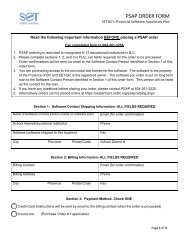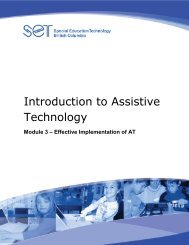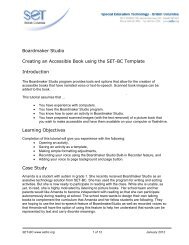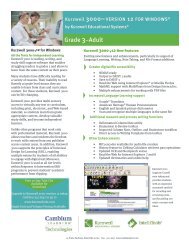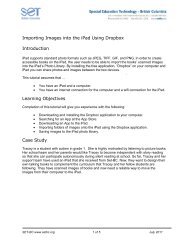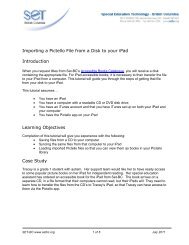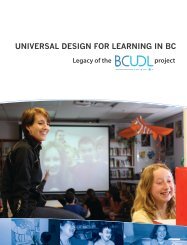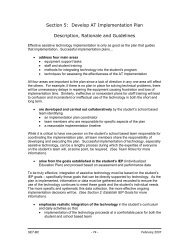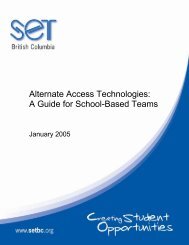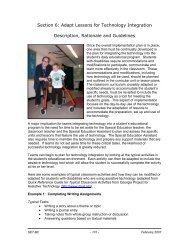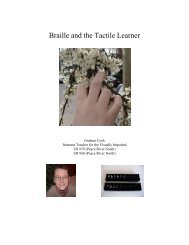Section 4: Identify Assistive Technology Solutions ... - Set BC
Section 4: Identify Assistive Technology Solutions ... - Set BC
Section 4: Identify Assistive Technology Solutions ... - Set BC
You also want an ePaper? Increase the reach of your titles
YUMPU automatically turns print PDFs into web optimized ePapers that Google loves.
<strong>Section</strong> 4: <strong>Identify</strong> <strong>Assistive</strong> <strong>Technology</strong> <strong>Solutions</strong><br />
Description, Rationale and Guidelines<br />
Once the AT trial phase is complete, it should be a relatively straightforward process to<br />
identify and select the assistive technology solution that will best meet the student’s<br />
needs and educational goals. Selection of the AT solution, then, would be the end result<br />
of the AT trial phase.<br />
For some teams, however, AT trials are not possible and identification of the AT solution<br />
must be made based on the student profile gathered in the first step of implementation<br />
and the identified IEP goals.<br />
When faced with the wide range of features now available in assistive devices and<br />
software, teams may become overwhelmed and struggle to narrow the options to one or<br />
two solutions. It is important for teams to access the necessary consultation and support<br />
from school or district staff who are knowledgeable in the field of assistive technology<br />
and who can make recommendations based on the student and team requirements.<br />
Teams may find it helpful to follow a three step process when selecting an AT solution<br />
for their students.<br />
1. Brainstorm all the possible solutions that would appear to meet the student<br />
and curricular needs.<br />
2. Narrow the list by identifying the various features of each solution and<br />
eliminating those that do not have the necessary features.<br />
3. Consider these additional questions and select the best solution.<br />
a. Will the technology work in all necessary settings or environments?<br />
b. If it will be moved regularly, how portable is it?<br />
c. How easy is it to learn and operate?<br />
d. How reliable is it under school and / or home conditions?<br />
e. Does it need to work with other technologies?<br />
f. Are there sufficient technical resources available at the school or<br />
district level to support the technology?<br />
No matter what solutions are suggested during the selection process, teams should<br />
consider the following general guidelines:<br />
• Match the features of the technology to the student need and IEP goals. As<br />
more and more assistive technologies are developed, manufacturers work hard<br />
to include as many features as possible in any one device or piece of software.<br />
The technology features should be matched, as closely as possible, to student<br />
need and IEP goals. Teams will often find that there are several possible<br />
solutions that could be considered. Careful examination of the individual<br />
features of the device or program usually narrows the choices and makes the<br />
appropriate solution more obvious. The importance of this consideration cannot<br />
be over emphasized – the research literature clearly shows that the most often<br />
reported cause of assistive technology abandonment is a mismatch of<br />
SET-<strong>BC</strong> - 59 - February 2007
technology features to student need. Teams often make the mistake of<br />
selecting the technology solution based on the technical potential of the device<br />
or software, rather than how well the technology would work for the specific<br />
student.<br />
An obvious example of this type of mismatch can occur when a middle or high<br />
school student requires technology to help with written output. The team<br />
assumes the student needs a laptop computer. However, there are dedicated<br />
word processors which are much simpler, more reliable, easier to manage, and<br />
more cost effective than laptops and provide the student with the exact tool that<br />
he or she might need to improve or increase written output. Teams implementing<br />
a laptop in that situation often find it is “too much” technology for the student and<br />
that it creates additional work and challenges for both the student and team.<br />
• Select technology that meets the student at their present level of<br />
functioning. It is important to put a technology solution in place that suits the<br />
student’s current level of functioning, but, since assistive technology can be<br />
costly, it is also important to consider the student’s potential growth. The<br />
challenge is finding technology that will serve the student effectively now and for<br />
as long as possible.<br />
• Look at possible technology solutions with a critical eye. Most assistive<br />
technology solutions offer a wide variety of features which may be superficially<br />
appealing. It is important that teams move past initial impressions and examine<br />
the various aspects of the technology critically. Teams should question the<br />
performance, ease of use, reliability, safety, practicality, cost effectiveness, and<br />
personal acceptance of any assistive technology solution before selecting it for<br />
the student.<br />
• Be prepared to change the technology solution if needed. The effective<br />
selection of an assistive technology solution is often more art than science.<br />
Because there are so many complex human factors to consider – the student’s<br />
and the team’s – and teams may be dealing with technology they have not<br />
actually implemented before - the initial selection (particularly if it is not informed<br />
by an AT trial) is a “best guess”. Once the technology is selected and put into<br />
place, teams should assess, as quickly as possible, whether or not the<br />
technology immediately meets the student’s physical and cognitive needs (e.g.<br />
the adapted mouse is the right size, the student can activate the AAC device,<br />
the computer screen is large enough for screen magnification, etc.). Team<br />
members who have expertise in functional assessments are key when<br />
determining if the assistive technology is a good “fit”. Based on these initial<br />
assessments, the assistive technology may have to be adjusted or replaced.<br />
Assessment of the overall effectiveness of the technology solution will then take<br />
place over time as part of the overall implementation plan.<br />
• Make use of the many tools that are available to help identify and compare<br />
the features of various technology solutions. There are many print and<br />
electronic tools that are now available to help teams with the AT selection<br />
process. Teams who do not have access to an assistive technology consultant<br />
can still make informed decisions based on information provided in AT feature<br />
SET-<strong>BC</strong> - 60 - February 2007
matrices, decision making software, and lists of possible AT solutions. Here are<br />
some examples of these AT selection tools:<br />
o EvaluWare: Assessment Activities for AAC and Computer Access<br />
Software that leads the user through the selection process based on<br />
responses to questions.<br />
http://www.assistivetech.com/p-evaluware.htm (free demo available)<br />
o LD Online (<strong>Assistive</strong> <strong>Technology</strong>)<br />
Website with many articles and links to help teams when selecting<br />
assistive technology.<br />
http://www.ldonline.org/indepth/technology<br />
o Closing the Gap (<strong>Solutions</strong>)<br />
Extensive website featuring a searchable software and hardware<br />
solutions database.<br />
http://www.closingthegap.com<br />
• Be realistic about the student’s capabilities. No matter how remarkable the<br />
features of the technology may be, the student can only take advantage of the<br />
features if they have the capability to do so. Each type of assistive technology<br />
has some basic prerequisites for use. For example, to use a computer, a<br />
student, at minimum, must understand cause and effect. Access to the<br />
computer can be accomplished through a myriad of ways (e.g. adapted mice,<br />
switches, lightpointers, etc.) but to be used effectively, the student must<br />
understand that their actions or behaviours cause something to happen on the<br />
computer. In the same way, successful use of a communication device is only<br />
possible if the student has, even at a rudimentary level, communicative intent.<br />
Having said this, it is not necessary for students to have all the prerequisite skills<br />
before a technology solution is put in place – it is only necessary that they have<br />
the potential capability to use the technology effectively.<br />
SET-<strong>BC</strong> - 61 - February 2007
Tools for <strong>Identify</strong>ing AT <strong>Solutions</strong><br />
There are a number of tools available to help identify appropriate AT solutions – some<br />
are more general and some are very technology specific. One of the challenges with<br />
technology is how quickly it evolves and changes. While technology feature matrices<br />
can be very valuable when narrowing the list of possible solutions, the information may<br />
go out of date quickly. Decisions must be based on the most current information<br />
possible – consulting with an assistive technology consultant helps ensure this will<br />
happen.<br />
1. The SETT Framework – Part II (Joy Zabala, 1998)<br />
(http://sweb.uky.edu/~jszaba0/SETTFORMS2003.PDF)<br />
The second part of the SETT framework provides forms for identifying features of AT<br />
systems and identifying the most promising AT tools.<br />
2. WATI <strong>Assistive</strong> <strong>Technology</strong> Assessment <strong>Technology</strong> Checklist<br />
(www.wati.org)<br />
One component of the larger WATI assessment package is their <strong>Technology</strong> Checklist.<br />
It lists possible AT solutions categorized by curriculum or student need. This checklist is<br />
often used when brainstorming possible solutions.<br />
3. Continuum of Considerations (University of Kentucky AT Project)<br />
(http://serc.gws.uky.edu/www/ukatii/index.html)<br />
A reinterpretation of the WATI checklist, the UKAT continuum offers a range of AT<br />
solutions from least adaptive to most adaptive for a large number of situations (e.g.<br />
computer access, communication, vision, learning / studying, etc.). This tool helps<br />
teams choose an appropriate level of technology solution.<br />
4. <strong>Assistive</strong> <strong>Technology</strong> Devices for Writing and Spelling<br />
(Georgia Project for <strong>Assistive</strong> <strong>Technology</strong> www.gpat.org)<br />
GPAT provides a number of updated technology feature matrices with the most<br />
commonly selected technology solutions organized according to task. The sample tool<br />
included here is for writing and spelling but matrices for augmentative communication,<br />
and study and organization are available.<br />
SET-<strong>BC</strong> - 62 - February 2007
SET-<strong>BC</strong> - 63 - February 2007
SET-<strong>BC</strong> - 64 - February 2007
SET-<strong>BC</strong> - 65 - February 2007
SET-<strong>BC</strong> - 66 - February 2007
SET-<strong>BC</strong> - 67 - February 2007
SET-<strong>BC</strong> - 68 - February 2007
SET-<strong>BC</strong> - 69 - February 2007
SET-<strong>BC</strong> - 70 - February 2007
SET-<strong>BC</strong> - 71 - February 2007
SET-<strong>BC</strong> - 72 - February 2007
Case Study of Effectively <strong>Identify</strong>ing an AT Solution<br />
Blaine is a bright Grade 5 student with low vision. He had been managing in class with<br />
minor adjustments – preferential setting, high contrast overhead, enlarged photocopies<br />
of text, etc. – but as the text load increased in the intermediate grades, his team noticed<br />
that he was tiring a great deal by the early afternoon. His classroom teacher requested<br />
a team meeting that included the vision teacher to discuss possible assistive technology<br />
solutions to help him complete the regular Grade 5 curriculum.<br />
At the meeting, everyone gave their perspective on Blaine’s needs and the vision<br />
teacher gave the team information on his vision issues. It was agreed that he required<br />
some sort of technology support, particularly because there was concern that his vision<br />
would deteriorate over time if he continued to strain to see the board and textual<br />
materials. During the meeting the team created a chart that looked something like this:<br />
Area of need<br />
Reading books<br />
Seeing board<br />
Tech features<br />
needed<br />
enlarge text from<br />
books, sheets,<br />
novels<br />
Bring what is written<br />
on board closer to<br />
him<br />
Possible technology<br />
CCTV<br />
Kurzweil 3000<br />
BookPort<br />
eText with talking<br />
word processor<br />
Microsoft eReader<br />
CCTV<br />
Monocular<br />
Meets need y/n<br />
Y<br />
Y<br />
N<br />
Y<br />
N<br />
Y<br />
Y<br />
From this chart, they were able to identify one type of device, a CCTV, that would meet<br />
both primary needs. The vision teacher then gave the team CCTV options – showing<br />
the team members the different features by going online and viewing the vendor<br />
websites. After much discussion about Blaine’s current and future needs, as well as the<br />
characteristics and features of the device, the team identified a Flipper and laptop<br />
(http://www.enhancedvision.co.uk/flipper_family.php) as the technology solution of<br />
choice. Blaine was brought into the meeting at this point and was shown the information<br />
about the device. At first he was somewhat reluctant as he was concerned that he<br />
would stand out from his peers using a “weird” laptop. However, with further explanation<br />
and some discussion as to how he would like to see it used, he became excited with the<br />
possibilities. His classroom teacher’s discussion about using the device to magnify bugs<br />
and worms for the whole class really won him over!<br />
The vision teacher agreed to pursue the acquisition of the equipment and the team<br />
scheduled a second meeting to develop the technology implementation plan that<br />
included an early assessment phase to ensure the Flipper was the right tool for Blaine in<br />
the Grade 5 classroom.<br />
SET-<strong>BC</strong> - 73 - February 2007



